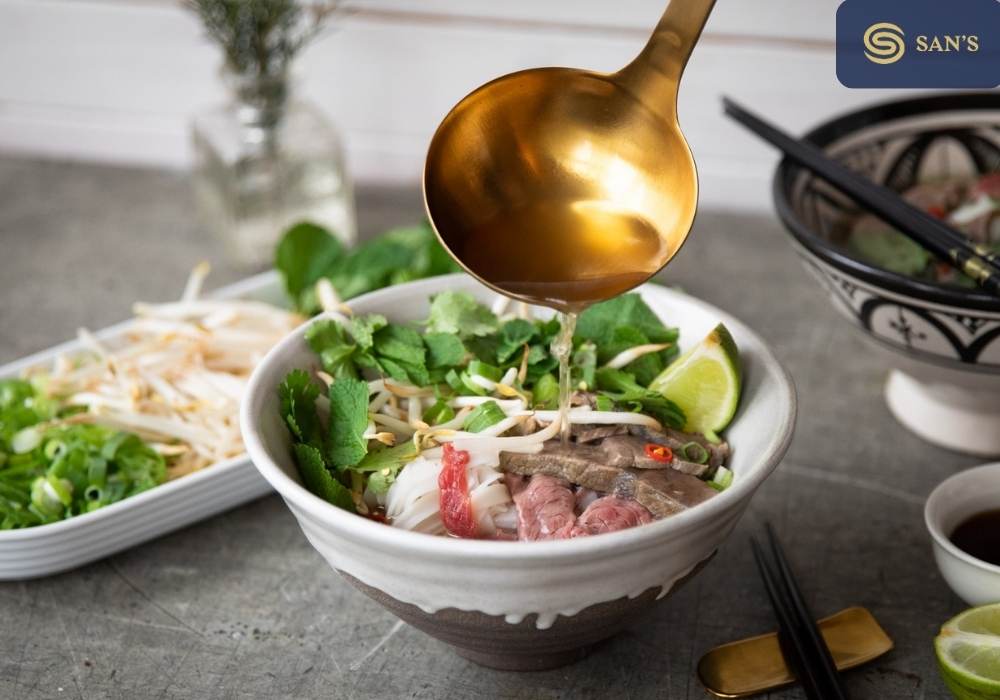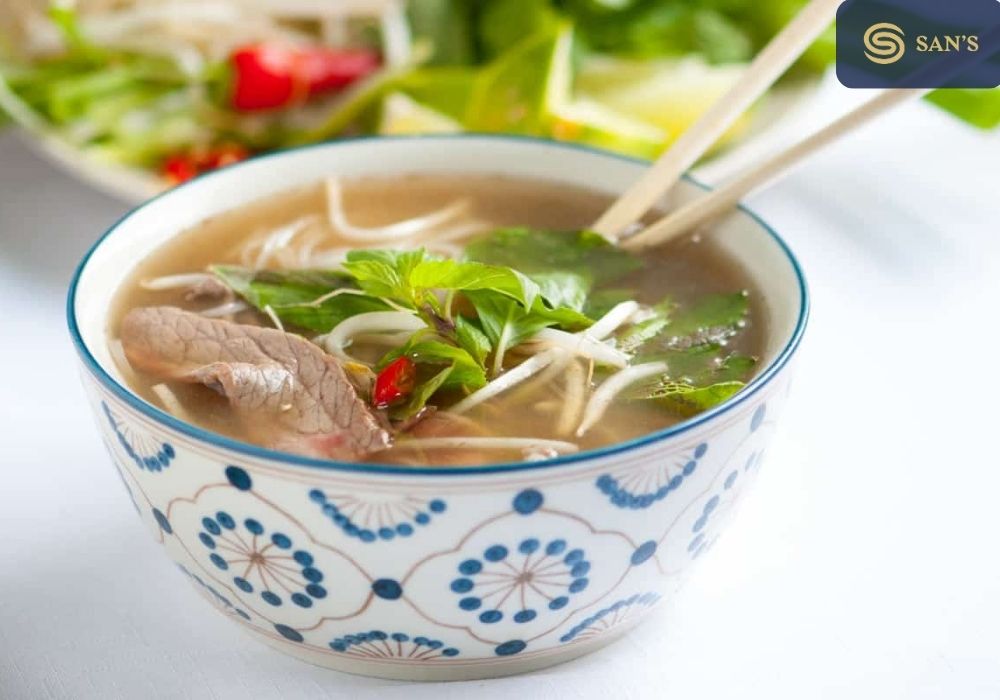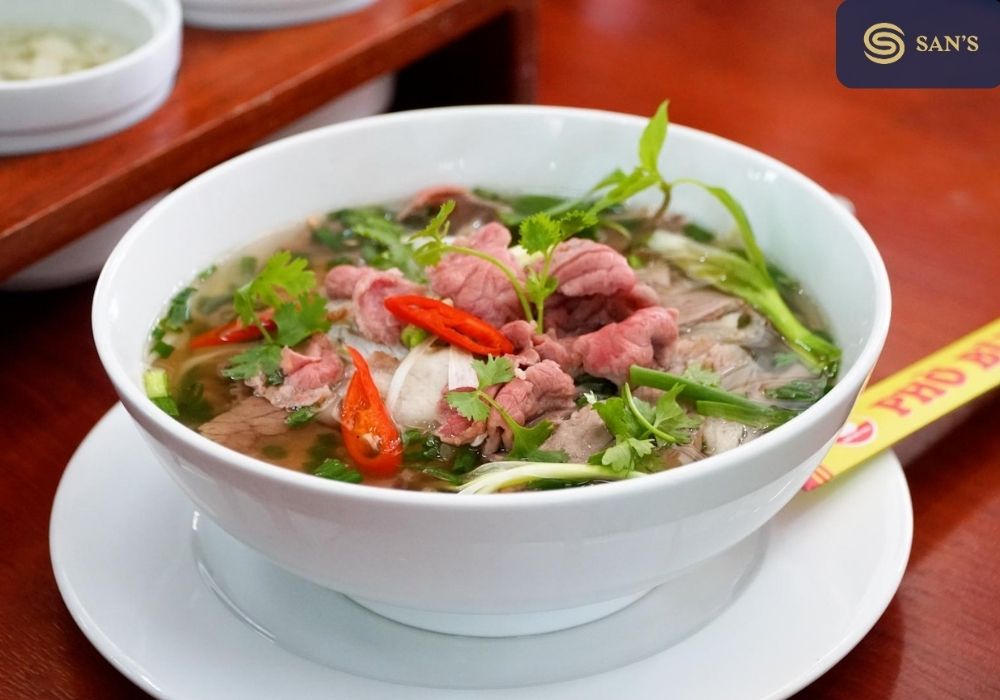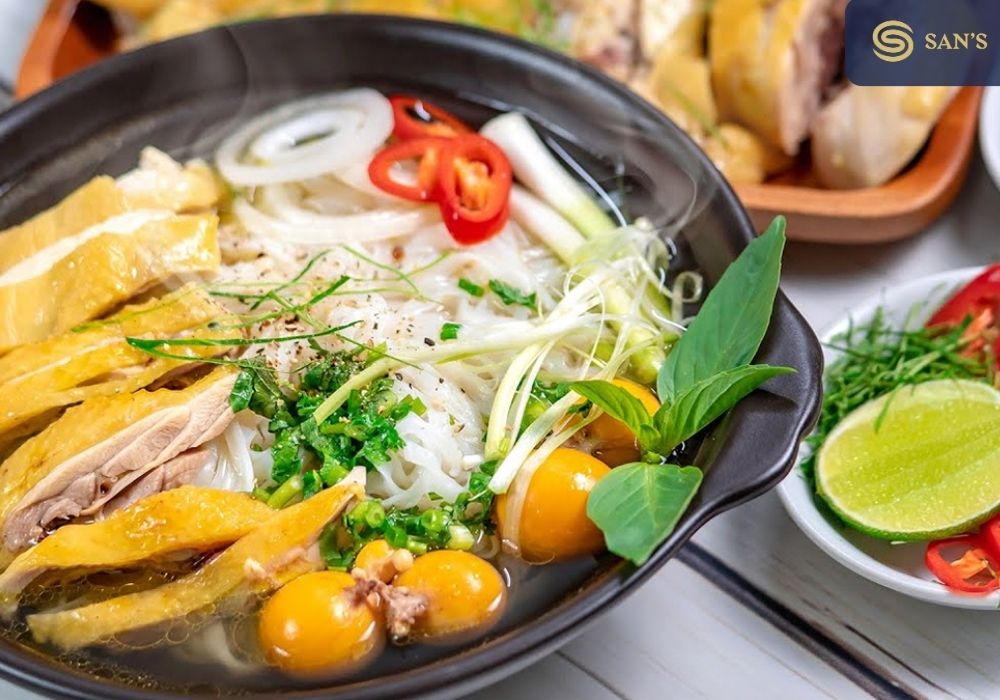Vietnamese cuisine is a harmonious blend of textures and flavors, characterized by its fresh ingredients, minimal use of dairy, and reliance on herbs and vegetables. Its rich history, shaped by a myriad of influences, from neighboring China to far-off France, has given birth to dishes that are as varied as they are flavorful. Amidst the diverse culinary landscape of Vietnam, one dish has managed to capture the imagination of food lovers worldwide – Pho.

Pho, pronounced “fuh,” is more than just a meal; it’s an embodiment of Vietnamese culture and history in a bowl. Steaming hot, fragrant broth poured over delicate rice noodles, topped with succulent slices of beef or chicken, and garnished with fresh herbs, it’s a symphony of flavors and textures that tells a story of its own. As we embark on this journey, let’s explore the intricacies of this iconic Vietnamese dish, unraveling its history, variations, and reasons for its unmatched global allure.
The Historical Roots of Pho
Nestled in the narrow streets and bustling markets of Northern Vietnam, particularly Hanoi, lies the birthplace of Pho. This dish, now synonymous with Vietnamese cuisine, has humble beginnings. Pho is believed to have originated in the early 20th century in the Nam Dinh and Hanoi regions of North Vietnam. The exact etymology of the word “Pho” remains debated, with some speculating its origins from the French dish “pot-au-feu,” suggesting a melding of French and Vietnamese culinary traditions.

Colonial times in Vietnam, marked by the French occupation, witnessed a confluence of culinary techniques and preferences. While the French brought with them beef-eating habits, the Vietnamese innovated, introducing the previously less-common meat into their traditional rice noodle soup. The fusion resulted in what we now recognize as Pho.
But beyond just culinary melding, Pho became a representation of resilience and adaptability of the Vietnamese people. In the face of foreign rule and cultural imposition, they managed to create something uniquely their own.
During these times, Pho was sold at dawn and dusk by roaming street vendors, who shouldered mobile kitchens with poles across their shoulders. The distinct sound of their wooden clappers announced the arrival of a hearty meal. This street-side culture, though evolved, remains integral to Vietnam’s food scene.
In essence, Pho is not just a dish; it’s a chapter from Vietnam’s historical and cultural tapestry, a testament to the nation’s enduring spirit and creativity in the face of adversities.
The Basic Ingredients
Dive into any bowl of Pho, and you’ll quickly realize it’s a culinary artwork composed of various elements, each contributing to its signature taste and texture. Let’s deconstruct this beloved Vietnamese dish to understand its primary components:
1. Broth: The soul of every Pho lies in its broth, often simmered for hours to extract the maximum flavor from beef or chicken bones. Infused with spices like star anise, cloves, cinnamon sticks, cardamom, and charred ginger and onions, this clear yet flavorful concoction sets the stage for the entire dish. The broth’s depth and clarity are crucial – it should be robust in flavor yet light in texture, representing a harmonious balance that makes Pho so enticing.
2. Noodles: Made from rice, these flat, slender noodles, often called ‘Bánh Phở,’ are soft, slippery, and delightfully chewy. Their neutral taste perfectly complements the savory broth and provides a smooth, silky texture to every bite. The quality and freshness of these noodles play a significant role, absorbing the essence of the broth while maintaining their distinct texture.
3. Meats: The most traditional meat option is thinly sliced beef, either served raw and cooked when the boiling broth is poured over it or cooked ahead and added to the bowl. Variants like Phở gà incorporate tender slices or chunks of chicken. Over the years, the dish has also seen a rise in other options like meatballs (Bò viên) or even seafood. The meats not only add protein to the dish but also infuse the broth with their essence.
4. Garnishes: No bowl of Pho is complete without its array of garnishes, allowing diners to customize each serving to their preference. Fresh herbs like basil, mint, and cilantro add aromatic complexity. Bean sprouts lend a crunchy contrast, while slices of chili and wedges of lime offer zesty overtones. Then there’s the Hoisin sauce and Sriracha, often served on the side, for those looking to add a touch of sweetness or heat. These garnishes aren’t mere afterthoughts; they play an essential role in enhancing and personalizing the Pho experience.

Understanding these basic ingredients is the key to appreciating the rich tapestry of flavors and textures that Pho presents. Every component, though simple on its own, comes together to create a dish that’s both comforting and complex.
The Art of Eating Pho
While Pho’s rich flavors and aromatic broth are undeniably its highlights, the experience of eating this traditional Vietnamese dish is an art form in itself. It’s not just about taste, but also about the ritual and the process, allowing diners to immerse themselves in a sensory journey. Let’s explore the etiquette and nuances that elevate the Pho-eating experience:
1. Traditional Etiquette and Steps to Enjoy Pho:
- The First Sniff: Before diving in, take a moment to inhale the steam rising from the bowl. This initial olfactory experience sets the stage for what’s to come.
- Utensil Mastery: Traditionally, Pho is enjoyed with a pair of chopsticks in one hand (to pick up noodles and meat) and a soup spoon in the other (to sip the broth). It’s customary to use both simultaneously.
- Broth First: Before mixing in herbs or sauces, take a sip of the broth. This allows you to appreciate its depth and clarity, understanding the essence of the dish.
- Noodle Lift: Use the chopsticks to lift a manageable portion of noodles. Dip them slightly in the broth before taking a bite, ensuring they’re well-coated.
- Meat Bites: Eat the meat pieces in between noodle bites. This alternation offers a balanced taste experience.
- Stay Leaned Forward: It’s customary (and practical) to lean slightly forward over your bowl, minimizing splashes and bringing you closer to the dish.
2. Customizing Your Bowl:
- Herbs: Depending on your preference, tear up basil leaves, mint, and other herbs, adding them to the bowl. These not only introduce fresh bursts of flavor but also enhance the soup’s aroma.
- Bean Sprouts: Add these for a crunchy texture. They’re typically added raw, allowing the hot broth to slightly soften them.
- Lime: A squeeze can introduce a tangy brightness, cutting through the richness of the broth.
- Chilies: For those who prefer a spicy kick, fresh chili slices can be added. Remember, a little goes a long way!
- Sauces: While purists might skip these, Hoisin and Sriracha are popular additions. Instead of pouring them directly into the bowl, it’s common to add a dab to a side dish and dip meat pieces before consuming.
- Taste and Tweak: The beauty of Pho lies in its adaptability. As you eat, feel free to adjust the flavors, adding more herbs or sauces to match your preference.
Eating Pho is not just about satiating hunger; it’s a meditative practice, a journey of flavors, and an embrace of Vietnamese culinary traditions. Whether you’re a first-timer or a seasoned enthusiast, the key is to savor each moment, each bite, and each sensation it offers.
Home-made Pho: Tips and Tricks
Creating an authentic bowl of Pho in the comfort of your own kitchen might seem daunting, but with the right ingredients and a touch of patience, it’s entirely feasible. Here’s a guide to help you recreate the magic of Pho at home:
-

Pho ga – Vietnamese Street Food
1. Essential Ingredients to Have:
- Bones: Beef bones (marrow and knuckle) for traditional Pho, or chicken bones for Pho Ga.
- Spices: Star anise, cloves, cinnamon sticks, coriander seeds, and cardamom pods.
- Aromatics: Fresh ginger and yellow onions.
- Rice Noodles: Look for flat rice stick noodles, often labeled as ‘Bánh Phở.’
- Proteins: Thinly sliced beef or chicken, depending on your preference. For beef, cuts like sirloin or tenderloin work best.
- Herbs and Garnishes: Fresh basil, cilantro, mint, bean sprouts, lime wedges, green onions, and chilies.
2. Steps to Make an Authentic Pho Broth at Home:
- Char the Aromatics: Place ginger and onions (with skin on) directly over a flame (like a gas stove or grill) until they are blackened. This imparts a unique smoky flavor to the broth.
- Parboil the Bones: Before simmering, boil your chosen bones for about 10 minutes to remove impurities. Discard the water and rinse the bones. This step ensures a clear broth.
- Slow Simmer: Place the cleaned bones in a large pot filled with fresh water. Add the charred ginger and onions, along with your spices (tied in a muslin cloth or spice bag). Let this mixture simmer gently for at least 6 hours for beef (3 hours for chicken), occasionally skimming off any foam or impurities that float to the surface.
- Seasoning: Once simmered, season the broth with fish sauce, sugar, and salt. Adjust these according to your taste.
- Strain and Serve: Strain the broth to remove bones, spices, and aromatics. Bring it back to a boil and pour over prepared noodles and meats in individual serving bowls.
3. Making it Vegetarian/Vegan: Possible Alternatives:
- Broth Base: Instead of meat bones, use a mix of hearty vegetables like mushrooms (shiitake is an excellent choice), daikon radish, and carrots. Seaweed or kelp can add depth to the broth.
- Protein Alternatives: Tofu, either soft or firm, can replace the meat slices. Seitan or tempeh can also be used for added texture.
- Fish Sauce Substitute: Use soy sauce or tamari (for a gluten-free option) to season the broth. There are also vegan fish sauce brands available in some markets.
- Additional Veggies: Bok choy, broccoli, and snap peas can be added to the bowl for more variety and nutrition.
FAQs
1. What exactly is Pho?
- Answer: Pho is a traditional Vietnamese noodle soup made from beef or chicken broth, flat rice noodles, and meat, usually beef or chicken. It’s typically garnished with ingredients like lime wedges, fresh herbs, and bean sprouts.
2. Is Pho pronounced as “Foe”?
- Answer: No, the correct pronunciation is more like “Fuh”.
3. How is Pho different from Ramen or other noodle soups?
- Answer: While Pho is Vietnamese and uses flat rice noodles with a clear and aromatic bone broth, Ramen is Japanese and uses wheat noodles with a typically richer and cloudier broth. Ingredients, preparation methods, and flavors differ significantly.
4. Is Pho always made with beef?
- Answer: No, while beef Pho is popular, there are variations made with chicken (Pho Ga) and even vegetarian and vegan versions.
5. How long does it take to prepare Pho at home?
- Answer: The broth, which is the essence of Pho, typically requires several hours of simmering to achieve its full flavor. However, with some shortcuts and modern cooking methods, quicker versions can be made in under an hour.
6. What are the health benefits of Pho?
- Answer: Pho, when made traditionally, contains bone broth rich in collagen and amino acids. The fresh herbs provide vitamins, while the proteins offer essential nutrients. It’s a balanced dish that can aid digestion, boost the immune system, and provide joint support.
7. Can I make a gluten-free version of Pho?
- Answer: Absolutely! Ensure that the rice noodles you’re using are purely rice-based, and be cautious with sauces like soy or hoisin. Opt for gluten-free alternatives or tamari instead.
8. Is it rude to slurp while eating Pho?
- Answer: In many Asian cultures, slurping is seen as a sign of appreciation and enjoyment of the meal. It’s not considered rude and, in fact, can enhance the flavor experience.
9. Why is my homemade Pho broth cloudy?
- Answer: Cloudiness can result from boiling the broth too vigorously. For a clear broth, it’s crucial to simmer it gently and skim off any impurities or foam that rise to the surface.
10. Can I store leftover Pho for later?
- Answer: Yes, you can refrigerate the broth and other components separately for up to 3 days. When reheating, ensure the broth comes to a boil before serving.





